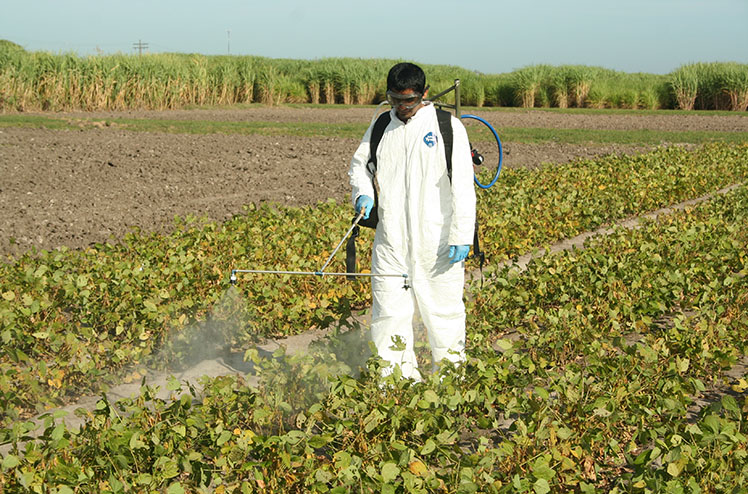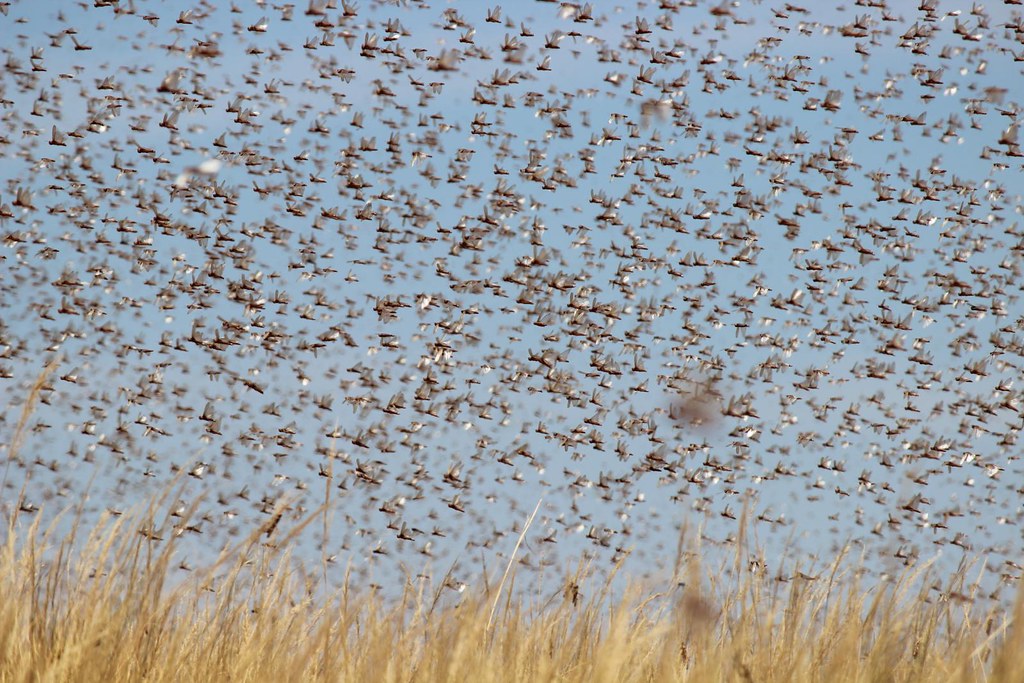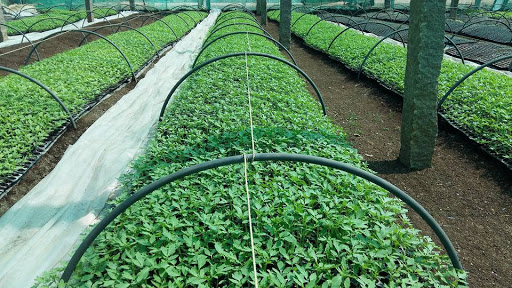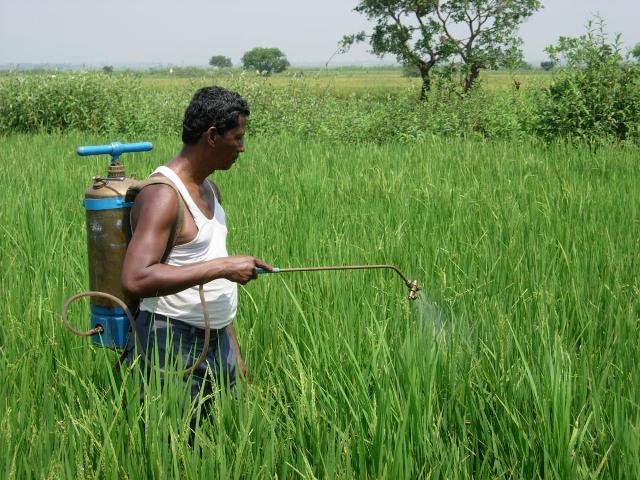- Fertilizer management is very important at the time of sowing the soybean crop.
- Similarly, spraying management is very important even after 20-25 days of sowing.
- This spray is very helpful for protecting the crop from pests and fungi of the soybean crops.
- For this, Lambda-Cyhalothrin 4.9% CS @ 200 ml / acre or Profenophos 50% SC @ 500 ml / acre
- Carbendazim 12% + Mancozeb 63% WP @ 300 gram / acre and seaweed @ 400 ml / acre and amino acids @ 300 ml / acre Or G A 0.001% @ 300 ml / acre
Nutrition Management in Maize
- In India Maize is cultivated in three seasons, Kharif (June to July), Rabi (October to November), and Zaid (February to March).
- For maximum benefit, it is necessary to check the soil before sowing. While preparing the land, 5 to 8 tons of well-decomposed cow dung manure should be added in the field.
- The amount of fertilizer and fertilizer applied in the fields also depends on the selected species. Adopting the right method and right fertilizer during maize cultivation benefits both the growth and production of maize.
- Adequate quantity of fertilizers should be given at the appropriate time to get maximum yield by hybrid and group varieties of maize after 10-15 days of sowing of maize.
- Urea 35 kg / acre + magnesium sulfate 5 kg / acre + zinc sulfate 5 kg / acre is very important after 10-15 days of maize sowing.
Helicopter services are now being sought to control locusts
Locust attacks have been taking place in states like Rajasthan, Madhya Pradesh, Uttar Pradesh for the last several weeks. In such a situation, several efforts have been made for locust control campaigns in India, due to which locust control is also getting success. In this episode, helicopters are also being used to control the locust team.
The Union Agriculture and Farmers Welfare Minister Shri Narendra Singh Tomar flagged off a Bell helicopter with spray equipment. The helicopter will leave for the Air Force Station at Uttarlai, Barmer, where it will initially be stationed and will control the locust attack in different areas from there.
The helicopter will be operated by a single pilot and has the capacity to carry 250 liters of pesticides at one go. This helicopter will spray pesticides in an area of 25 to 50 hectares at a time.
Earlier, India has also done something to control locusts, which is being praised all over the world. Actually, India has resorted to drones for locust control and has also become the first country in the world to do so.
Source: Krishak Jagat
ShareFarmers of Madhya Pradesh will get huge discount in electricity bill
The farmers have suffered financially due to the nationwide lock-down that began in the last week of March. In view of this, the central government along with different state governments is providing financial assistance to the farmers. In this sequence, the Government of Madhya Pradesh has decided to provide relief to farmers in agriculture as well as domestic electricity bills.
Under this exemption, all such domestic consumers of the state who are beneficiaries of Sambal Yojana and whose monthly bill was up to Rs 100 in April 2020, their next three months i.e. May, June, and July 2020, the amount will come to Rs 100. But in these three months, only 50 rupees per month are being charged from them.
Apart from this, all household users whose bills were up to Rs 100 in the month of April 2020, when the amount of the bills in the next three months i.e. May, June, and July 2020 comes from Rs 100 to Rs 400, then from them only 100 in these three months. An amount of Rs. Per month is being taken.
Source: Kisan Samadhan
ShareWeed Management in Soybean Crop
-
- Soybean crop is the main crop of the Kharif season.
- Due to sowing in kharif, there are a lot of outbreaks of weeds in soybean crop.
- For the first use of germination (1-3 days after sowing):
-
- Imazethapyr 2% + Pendimethalin 30%EC @ 700 ml / acre Or Diclosulam 84% WDG @ 12.4 g / acre
- 12 -18 days after sowing:
- Fomesafen11.1% + Fluazifop-P-Butyl11.1%SL @ 400 ml / acre fusiflex) Or Chlorimuron Ethyl25% @ 15 gram / acre or Or Sodium acifluorfen16.5% + Clodinafop propargyl 8%EC @ 400 gram/ acre or Or Imazethapyr 10%SL @ 400 ml / acre or Propaquizafop 2.5%+ Imazethapyr 3.75% WP 800 ml/acre
Nursery treatment in Tomato
- 1 x 3 m bed required for nursery. use well-decomposed cow dung and DAP per sqm.
- Seeds are treatment done with Carbendazim + Mancozeb @ 3 gram/kg or Trichoderma @ 5 gram/kg seed Treated seed Sow in rows keeping a distance of 5 cm Cover with cow dung manure or soil after sowing the seeds
- Drenching in nursery 7 days after nursery sowing with chlorothalonil 75% WP @ 30 gm in 15 ltr water and thiamethoxam 25% WG @ 10 gm in 15 ltr water.
- After 20 days of nursery sowing, before transplant the seedlings in the main field are treated with metalaxyl 8% + mancozeb 64% @ 60 gram in 15 liter and fipronil 40% + imidacloprid 40% WG @ 5 gram 15 liter water.
- Transplant marigold around the farm. In the blooming stage, fruit penetrating insects give less egg in tomato crops and more eggs in marigold/flowers.
Spray Management in Paddy Nursery
- Paddy cultivation starts from the nursery, so it is important to have good seeds. Many times the farmer applies expensive seed and manure, but the right yield is not available, so the seed and field should be treated before sowing. Seeds do not have to be expensive but should be reliable and according to the climate and soil of your area.
- Spray management is very important for the prevention of insect bites and good growth of nursery 15-20 days after nursery sowing.
- Sometimes in the nursery, there are an attack of hopper, stem borer pests, in such a situation it is very important to control it
- For this, use Fipronil 5% SC @ 30 ml / pump and Kasugamycin 5% + Copper Oxychloride 45% WP @ 20 gram / pump and Humic Acid @ 20 gram / pump.







